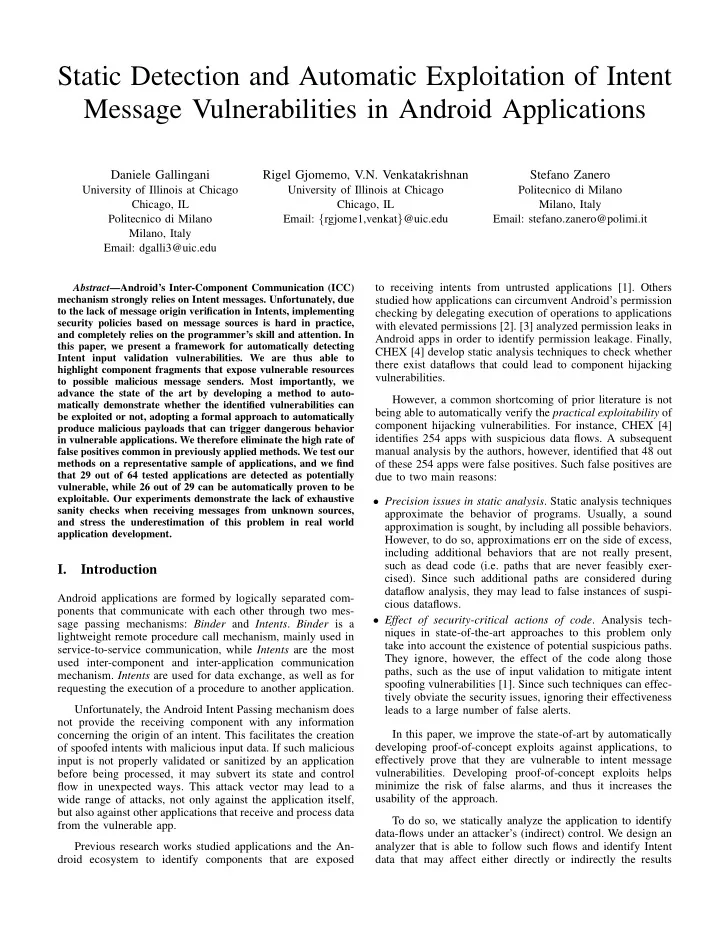

Static Detection and Automatic Exploitation of Intent Message Vulnerabilities in Android Applications Daniele Gallingani Rigel Gjomemo, V.N. Venkatakrishnan Stefano Zanero University of Illinois at Chicago University of Illinois at Chicago Politecnico di Milano Chicago, IL Chicago, IL Milano, Italy Email: { rgjome1,venkat } @uic.edu Politecnico di Milano Email: stefano.zanero@polimi.it Milano, Italy Email: dgalli3@uic.edu to receiving intents from untrusted applications [1]. Others Abstract —Android’s Inter-Component Communication (ICC) mechanism strongly relies on Intent messages. Unfortunately, due studied how applications can circumvent Android’s permission to the lack of message origin verification in Intents, implementing checking by delegating execution of operations to applications security policies based on message sources is hard in practice, with elevated permissions [2]. [3] analyzed permission leaks in and completely relies on the programmer’s skill and attention. In Android apps in order to identify permission leakage. Finally, this paper, we present a framework for automatically detecting CHEX [4] develop static analysis techniques to check whether Intent input validation vulnerabilities. We are thus able to there exist dataflows that could lead to component hijacking highlight component fragments that expose vulnerable resources vulnerabilities. to possible malicious message senders. Most importantly, we advance the state of the art by developing a method to auto- However, a common shortcoming of prior literature is not matically demonstrate whether the identified vulnerabilities can being able to automatically verify the practical exploitability of be exploited or not, adopting a formal approach to automatically component hijacking vulnerabilities. For instance, CHEX [4] produce malicious payloads that can trigger dangerous behavior identifies 254 apps with suspicious data flows. A subsequent in vulnerable applications. We therefore eliminate the high rate of manual analysis by the authors, however, identified that 48 out false positives common in previously applied methods. We test our methods on a representative sample of applications, and we find of these 254 apps were false positives. Such false positives are that 29 out of 64 tested applications are detected as potentially due to two main reasons: vulnerable, while 26 out of 29 can be automatically proven to be exploitable. Our experiments demonstrate the lack of exhaustive • Precision issues in static analysis . Static analysis techniques sanity checks when receiving messages from unknown sources, approximate the behavior of programs. Usually, a sound and stress the underestimation of this problem in real world approximation is sought, by including all possible behaviors. application development. However, to do so, approximations err on the side of excess, including additional behaviors that are not really present, such as dead code (i.e. paths that are never feasibly exer- I. Introduction cised). Since such additional paths are considered during dataflow analysis, they may lead to false instances of suspi- Android applications are formed by logically separated com- cious dataflows. ponents that communicate with each other through two mes- • Effect of security-critical actions of code . Analysis tech- sage passing mechanisms: Binder and Intents . Binder is a niques in state-of-the-art approaches to this problem only lightweight remote procedure call mechanism, mainly used in take into account the existence of potential suspicious paths. service-to-service communication, while Intents are the most They ignore, however, the effect of the code along those used inter-component and inter-application communication paths, such as the use of input validation to mitigate intent mechanism. Intents are used for data exchange, as well as for spoofing vulnerabilities [1]. Since such techniques can effec- requesting the execution of a procedure to another application. tively obviate the security issues, ignoring their effectiveness Unfortunately, the Android Intent Passing mechanism does leads to a large number of false alerts. not provide the receiving component with any information In this paper, we improve the state-of-art by automatically concerning the origin of an intent. This facilitates the creation developing proof-of-concept exploits against applications, to of spoofed intents with malicious input data. If such malicious input is not properly validated or sanitized by an application effectively prove that they are vulnerable to intent message before being processed, it may subvert its state and control vulnerabilities. Developing proof-of-concept exploits helps flow in unexpected ways. This attack vector may lead to a minimize the risk of false alarms, and thus it increases the wide range of attacks, not only against the application itself, usability of the approach. but also against other applications that receive and process data To do so, we statically analyze the application to identify from the vulnerable app. data-flows under an attacker’s (indirect) control. We design an Previous research works studied applications and the An- analyzer that is able to follow such flows and identify Intent droid ecosystem to identify components that are exposed data that may affect either directly or indirectly the results
Recommend
More recommend